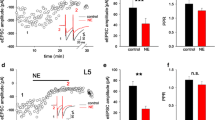Abstract
Excitatory amino acids such asl-glutamate (Glu) and quisqualate (QUIS) markedly potentiated K+-evoked release of exogeneous [3H]dopamine (DA) from rat striatal slices. Intranstriatal kainic acid injections resulted in a total disappearance of the stimulatory effects of Glu on evoked-release of [3H]DA as well as in a parallel reduction in the maximal number (Bmax) of ad-aspartate-insensitivel-[3H]Glu binding site in striatal particulate fractions. Following cortical ablation, the potentiating effect of Glu on [3H]DA release in decorticated striatal slices lasted longer, compared to normal slices, and occured during the 2nd min following K+-depolarization. However, the extent (%) of Glu stimulation on [3H]DA release remained the same in decorticated and normal striatal slices. Cortical ablation produced also a significant decrease in the Bmax and in theK d′ of thed-aspartateinsensitive binding site towardsl[3H]Glu. These results support the proposal that thed-aspartate-insensitive Glu binding site is somehow related to an amino acid receptor-mediated modulation of dopaminergic transmission in the rat corpus striatum.
Similar content being viewed by others
References
Giorguieff, M. F., Kemel, M. L., andGlowinski, J. 1977. Presynaptic effects ofl-glutamic acid on the release of dopamine in rat striatal slices. Neurosci. Lett. 6:73–77.
Roberts, P. J., andAnderson, J. D. 1979. Stimulatory effects ofl-glutamate and related acid on [3H]dopamine release from rat striatum: an in vitro model for glutamate actions. J. Neurochem. 32:1539–1545.
Rudolph, M. I., Arqueros, L., andBustos, G. 1983.l-glutamic acid, a neuromodulator of synaptic transmission in the rat corpus striatum.. Neurochem. Intern. 5:479–486.
Rudolph, M. I., andBustos, G. Search of al-glutamate receptor related to modulation of neurotransmission in the rat corpus striatum. Neurochem Intern (in press).
Schwarcz, R., andCoyle, J. T. 1977. Striatal lesions with kainic acid: neurochemical characteristics. Brain Res. 127:235–249.
Fagg, G. E., andFoster, A. C. 1983. Amino acid neurotransmitters and their pathways in the mammalian central nervous system. Neuroscience 9:701–719.
Fonnum, F. 1984. Glutamate: a neurotransmitter in the mammalian brain. J. Neurochem. 42:1–11.
Rudolph, M. I., andBustos, G. 1981. Participation of striatal intrinsic neurons on the effect ofl-glutamic acid upon dopamine release. Arch. Biol. Med. Exp. 14:294.
Rudolph, M. I., andBustos, G. 1983. Characterization of al-glutamate receptor in the rat corpus striatum. Arch. Biol. Med. Exp. 16:R-116.
McGeer, P. L., McGeer, E. G., Scherer, U., andSingh, K. 1977. A glutamatergic corticostriatal path? Brain Res. 128:369–373.
Arqueros, L., Abarca, J., andBustos, G. 1985. Release ofd-[3H]aspartic acid from the rat striatum. Effect of veratridine-evoked depolarization, fronto-parietal cortex ablation and striatal lesions with kainic acid. Biochem. Pharmacol. 34:1217–1224.
Schrier, B. R., andShuster, L. 1967. A simplified radiochemical assay for choline acetyltransferase. J. Neurochem. 14:977–985.
Laverty, R., andTaylor, K. M. 1968. The fluorometric assay of catecholamines and related compounds. Anal. Biochem. 22:269–279.
Bustos, G., andRoth, R. H. 1972. Release of monoamines from the striatum and hypothalamus effect of γ-hydroxybutyrate. Brit. J. Pharmacol. 46:101–115.
Lowry, O. H., Rosebrough, N. S., Farr, A.-L., andRandall, R. J. 1951. Protein measurement with the Folin phenol reagent. J. Biol. Chem. 193:265–275.
Scatchard, G. 1949. The attractions of proteins for small molecules and ions. Ann. New York Acad. Sci. 51:660–672.
Bennett Jr., J. P. 1978. Methods in binding studies, Pages 57–90,in Yamamura, H. I., Enna, S. J., andKuhar, M. J. (eds.). Neurotransmitter receptor binding. Raven Press, New York.
Watkins, J. C., andEvans, R. H. 1981. Excitatory amino acid transmitter. Ann. Rev. Pharmacol. Toxicol. 21:165–204.
Mc. Lennan, H. 1981. Excitatory amino acid receptor, Pages 215–220,in,Lombardini,J. B. andKenny,A. D. (eds.) The role of peptides and amino acids as neurotransmitter, Alan R. Liss, New York.
Monaghan, D. T., Yao, D., andCotman, C. W. 1985.l-[3H]Glutamate binds to kainate-NMDA-and AMPA-sensitive binding sites: an autoradiographic analysis. Brain Res. 340:378–383.
Robinson, M. B., Crooks, S. L., Johnson, R. L., andKoerner, J. F. 1985. Displacement ofDl-[3H]-2-amino-4-phosphonobutanoic Acid binding with methyl-substituted APB analogues and glutamate agonists. Biochemistry 24:2401–2405.
Kitai, S. T., Kocsis, J. D., Preston, R. J., andSugimori, M. 1976. Monosynaptic inputs to caudate neurons identified by intracellular injection of horseradish peroxidase. Brain Res. 109:601–606.
Hattori, T., andFibiger, H. C. 1982. On the use of lesions of afferents to localize neurotransmitter receptor sites in the striatum.. Brain Res. 238:245–250.
Pinching, A. J., andPowell, T. P. S. 1971. Ultra-structural features of transneuronal cell degeneration in the olfactory system J. Cell Sci. 8:253–268.
Ghetti, B., andWisniewsky, H. M. 1972. On degeneration of terminals in, the cat striate cortex. Brain Res. 44:630–635.
Ghetti, B., Horoupian, D. S., andWisniewsky, H. M. 1972. Transsynaptic response of the lateral geniculate nucleus and the pattern of degeneration of the nerve terminals in the rhesus monkey after eye enucleation. Brain Res. 45:31–48.
Roberts, P. J., Mc. Bean, J. G., Sharif, N. A., andThoma, E. M. 1982. Striatal glutamatergic function: modifications following specific, lesions. Brain Res. 235:83–91.
Biziere, K. Thompson, H., andCoyle, J. T. 1980. Characterization of specific, highaffinity binding sites forl-[3H]glutamic acid in rat brain membranes. Brain Res. 183:421–433.
Mc Lennan, H. 1980. The effect of decortication on the excitatory amino acid sensitivity of striatal neurons. 18:313–316.
Author information
Authors and Affiliations
Rights and permissions
About this article
Cite this article
Isolde Rudolph, M., Bustos, G. Functional and biochemical characteristics of a putative quisqualate-type receptor in rat striatum: Effect of brain lesions. Neurochem Res 11, 1533–1545 (1986). https://doi.org/10.1007/BF00965772
Accepted:
Issue Date:
DOI: https://doi.org/10.1007/BF00965772




